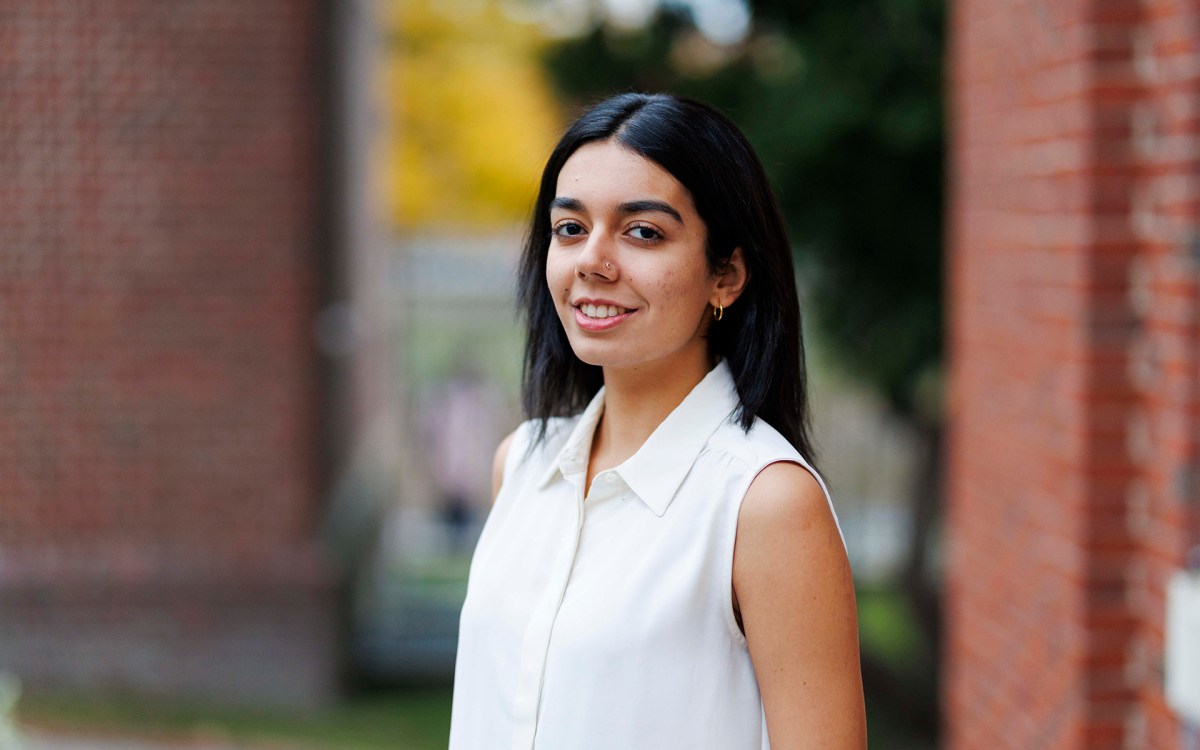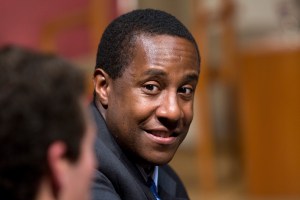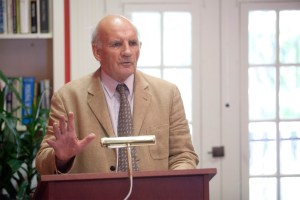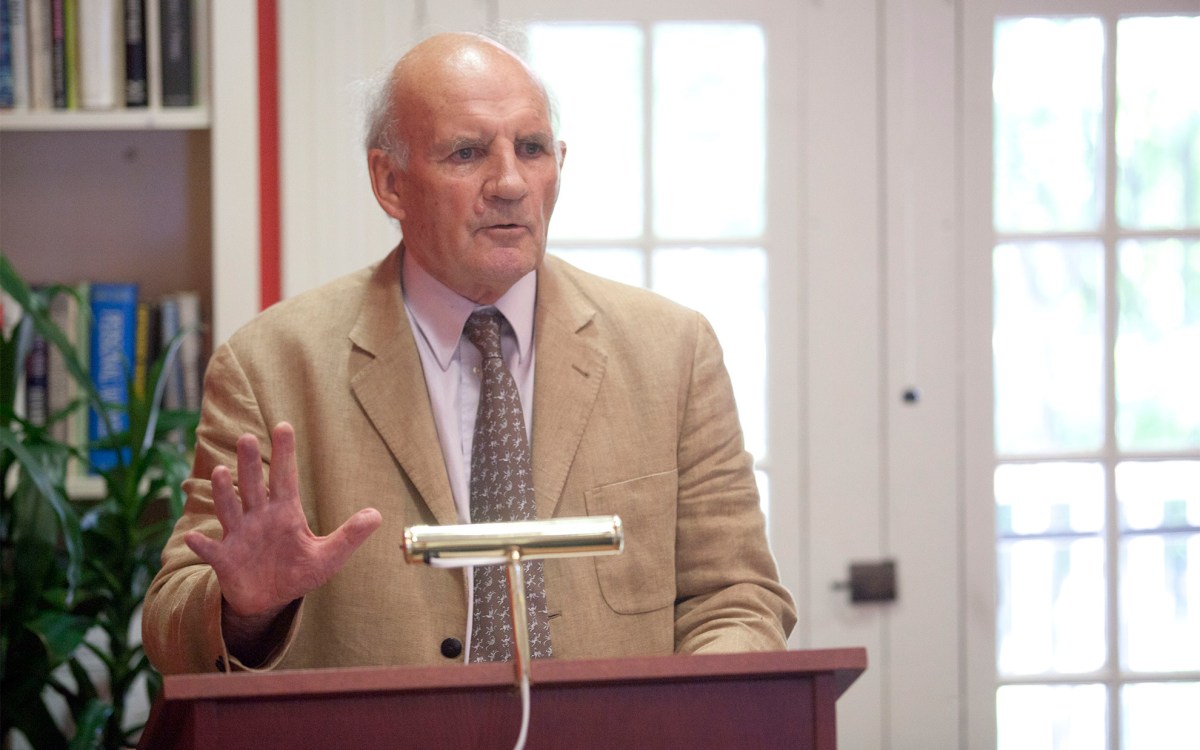Honorary degrees awarded at Commencement
Harvard University today (June 5) conferred honorary doctoral degrees on 10 individuals in recognition of their outstanding achievements in a broad range of fields. The degrees were awarded at this morning’s 357th Commencement Exercises.
In addition, the University announced its intention to confer an honorary degree on Sen. Edward M. Kennedy on an appropriate future occasion. Kennedy had planned to attend today’s Commencement ceremony but is now recovering from surgery earlier this week.
His Highness the Aga Khan
Doctor of Laws
His Highness the Aga Khan — Prince Karim al Hussayni A.B. ’59 — was a 20-year-old junior at Harvard College when on July 11, 1957, he became the present Aga Khan IV, upon the death of his grandfather, Aga Khan III.
“Aga Khan” is the hereditary title of the imam (spiritual leader) of the Shia Imami Ismaili Muslims, a branch of the faith represented in about 25 countries.
The Aga Khan is the 49th hereditary imam. He traces his lineage to Ali, cousin of Muhammad, and his wife Fatima, Muhammad’s daughter. He left Harvard in 1957, but returned a year later and graduated in 1959 with an honors degree in Islamic history.
Born in 1936 in Geneva, Switzerland, the Aga Khan spent his early childhood in Nairobi, Kenya, (where he was educated by tutors) and then nine years at Le Rosey School in Switzerland.
Today, the Aga Khan — a father of four whose passion is raising and racing thoroughbred horses — is founder and chairman of the Aga Khan Development Network (AKDN), one of the largest private development groups in the world. AKDN operates social, economic, and cultural entities, particularly to benefit the Third World.
Service in international affairs is a family tradition. The Aga Khan’s grandfather was president of the League of Nations. His father, Prince Aly Khan (whose second wife was Hollywood actress Rita Hayworth), was Pakistan’s ambassador to the United Nations.
Harvard is a family tradition as well. The Aga Khan’s uncle, Prince Sadruddin Aga Khan, graduated from Harvard College in 1954 and went on to become the United Nations’ High Commissioner for Refugees. The Aga Khan’s brother, Prince Amyn, graduated from Harvard in 1965.
And the Aga Khan’s eldest child and daughter, Princess Zahra, graduated in 1994 with an honors degree in development studies. She directs the AKDN’s social welfare department.
James P. Comer
Doctor of Laws
James P. Comer is the Maurice Falk Professor of Child Psychiatry at the Yale University School of Medicine’s Child Study Center.
He is internationally known for his research in the area of child development and education.
Comer’s parents, particularly his mother, instilled in him the importance of education and took an active interest in his studies and early development. His childhood experience informed his own work in the field, leading ultimately to his influential model, which asserts that parents play a vital role in the academic success of their children.
After receiving his A.B. degree from Indiana University, Comer considered becoming a general practitioner. But his time living and working in Washington, D.C., where he attended medical school at Howard University and where he was exposed to the poor social conditions of many of the city’s low-income minorities, led him to the field of public health and child psychiatry. He received his master’s of public health degree from the University of Michigan School of Public Health in 1964. He completed his psychiatry training at the Yale School of Medicine, the Yale Child Study Center, and the Hillcrest Children’s Center in Washington, D.C.
At Yale’s Child Study Center in 1968, he helped develop a research project for two inner-city elementary schools that would become the basis for a revolutionary new vision of education and child welfare. The project, the Comer School Development Program, stresses a collaborative approach that involves teachers, parents, and community resources in improving a child’s social, emotional, and academic outcomes. The program has been implemented in hundreds of school systems across the country.
Comer has written widely on education, child development, and race relations. He holds 43 honorary degrees and is a co-founder and past president of the Black Psychiatrists of America. He has served as a consultant to the Public Committee on Mental Health chaired by Rosalyn Carter, and has advised numerous national organizations serving children.
Wen C. Fong
Doctor of Arts
Wen Chih Fong was born in Shanghai, China, in 1930, and received his M.F.A. and Ph.D. from Princeton University, where he went on to teach art and archaeology for 45 years, until his retirement in 1999. (He is still a professor emeritus at Princeton.)
Fong also had a long career (1971-2000) as a consultant at the Metropolitan Museum of Art in Manhattan, where he transformed a then-sleepy and small Department of Far Eastern Art (one gallery, one installation, two curators) into a robust and comprehensive Asian Art Department.
Upon his retirement, the Met’s department oversaw the world’s largest collection of Asian art. Fifty permanent galleries occupied 64,500 square feet of space. The number of full-time curators had risen to 13 including experts in Japanese painting, Buddhist sculpture, archaeology, ceramics, textiles, Chinese painting, and Indian and Tibetan painting.
In three decades with the Metropolitan, Fong employed his trademark patience, persistence, and optimism to build a vast, encyclopedic collection. He expanded galleries, modernized the conservation program, drew in milestone gifts and acquisitions, and organized dozens of acclaimed exhibitions. One of them, the 1996 “Splendors of Imperial China: Treasures from the National Palace Museum, Taipei,” brought in 800,000 visitors.
During his 45 years at Princeton, where in 1959 he established the first U.S. Ph.D. program in Chinese art and archaeology, Fong wrote, co-wrote, or edited 18 books and catalogs, along with numerous articles for every prestigious scholarly publication in the world specializing in Asian art.
Fong’s teaching and scholarship broke new ground. He boldly crossed art history with many other disciplines, including literature, political and social history, geography, religion, anthropology, and religion.
Fittingly, a 2006 Princeton symposium on East Asian Art, held in Fong’s honor, was titled “Bridges to Heaven.”
Eric R. Kandel
Doctor of Science
Eric R. Kandel, University Professor at Columbia University, is renowned for his studies of memory formation in the brain. Working with the simple neural system of a sea slug, Kandel unraveled how both short-term and long-term memories are formed.
The work won him the 2000 Nobel Prize in physiology or medicine, shared with Arvid Carlsson and Paul Greengard, for their work on “signal transduction in the nervous system.”
Kandel’s portion of the prize was awarded specifically for “revealing molecular mechanisms, important for the formation of memories.” Kandel graduated from Harvard College and received an M.D. from New York University. He trained in neurobiology at the National Institutes of Health and in psychiatry at Harvard Medical School. He joined Columbia’s College of Physicians and Surgeons in 1974 as the founding director of the Center for Neurobiology and Behavior.
Today, Kandel is also the Fred Kavli Professor and director of the Kavli Institute for Brain Science and a senior investigator at the Howard Hughes Medical Institute.
His recent work has focused on memory disorders and mental illness in mouse models. He has received 16 honorary degrees, is a member of the U.S. National Academy of Sciences and the National Science Academies of Germany and France. He has received numerous awards and honors, including the Albert Lasker Award, the Heineken Award of The Netherlands, the Gairdner Award of Canada, the Wolf Prize of Israel, and the National Medal of Science in the United States.
In his Nobel autobiography, Kandel writes of the importance of his childhood years spent in his native Austria, where as a 9-year-old he witnessed the Nazi rampage of Kristallnacht. That explosion of violence and the following year during which his family lived under Nazi rule before emigrating to the United States made a deep impression on him and started him wondering about the workings of the human mind, which he has spent a career exploring.
The Hon. Damon J. Keith
Doctor of Laws
A dedication to civil rights, the law, upholding the Constitution, and maintaining a firm check on power all define the life of the Honorable Damon J. Keith of the 6th U.S. Court of Appeals.
The youngest of six children, Keith grew up in Detroit, where he attended Northwestern High School. Upon receiving his bachelor’s degree from West Virginia State College, he was drafted and served in the Army from 1943 to 1946.
Keith earned his J.D. in 1949 from Howard University where he was elected Chief Justice of the Court of Peers. In 1956 he received his LL.M. from Wayne State University Law School in Detroit.
Following school, Keith established a private practice, which he eventually expanded to include several partners. Over the years his Detroit firm, Keith, Conyers, Anderson, Brown & Wahls became known as a staunch champion of civil rights.
From 1967 to 1977 he was a judge in the U.S. District Court for the Eastern District of Michigan, where he was elevated to chief judge in 1975. He has served as a judge in the U.S. Court of Appeals for the 6th Circuit since 1977, and as senior judge in that capacity since 1995.
Keith is known for issuing a number of key rulings, including the 1973 Stamps v. Detroit Edison Co. decision, which fined the Detroit Edison Company $4 million for its practice of racial discrimination and required that it implement an affirmative action program.
His most famous decision is United States v. Sinclair (1971). Commonly referred to as the “Keith Decision,” it determined that the federal government could not conduct domestic wiretaps without a warrant. The U.S. Supreme Court unanimously upheld his decision.
Keith holds more than 40 honorary degrees. He is a member of the American, National, Detroit, and Michigan bar associations; the National Lawyers Guild; and the American Judicature Society.
Gerda Lerner
Doctor of Letters
Gerda Lerner is Robinson-Edwards Professor of History Emerita at the University of Wisconsin, Madison, and a visiting member of the history department at Duke University.
Credited with the development of the curriculum of women’s history at numerous academic institutions, Lerner is widely recognized as having introduced women’s history as a formal academic field. A past president of the Organization of American Historians, she is also well known as an advocate of civil and women’s rights and was a founding member of the National Organization for Women.
A young member of the anti-Nazi resistance, Lerner fled to the United States from Hitler-occupied Austria in 1939 at the age of 18. Later, she was a member of the Communist Party in the United States.
After raising a family, she returned to school to further her education. She was in her 40s when she received her A.B. from the New School for Social Research in New York, and her M.A. and Ph.D. from Columbia University.
Lerner has studied and written widely on African-American history. Her early work as an author included her 1955 semi-autobiographical novel “No Farewell,” which detailed life in Austria in the 1930s, and the screenplay “Black Like Me” in 1964. Her most recent work is her memoir “Fireweed: A Political Autobiography” (2002).
Lerner founded and co-directed the country’s first graduate program in women’s history at Sarah Lawrence College in 1972. In 1980 she founded and directed the graduate program in women’s history at the University of Wisconsin, Madison. She also co-founded the Seminar on Women at Columbia University.
Lerner’s numerous honors and awards include the American Historical Association’s Award for Scholarly Distinction in 1992. She was awarded the honorary Austrian Cross of Honor for Science and Art in 1996, and in 2002 she was the first woman to receive the Bruce Catton Prize for Lifetime Achievement in Historical Writing.
John McCarthy
Doctor of Science
Boston-born, California-raised, and Princeton-trained mathematician and cognitive scientist John McCarthy, a professor emeritus of computer science at Stanford University, has been interested in artificial intelligence (AI) since 1948 — and formally coined the term in 1955.
In 1958, McCarthy invented the Lisp (“list processing”) computer language, the second-oldest high-level programming language in use today. (Only Fortran is older.) It quickly became the favored programming language for AI research.
McCarthy’s main research in AI involves how to formalize common-sense knowledge. His circumscription method of nonmonotonic reasoning, developed from 1978 to 1986, formalizes some aspects of human informal reasoning. It allows a computer program, in effect, to “jump to a conclusion.”
But AI can only go so far. On his Web site (http://www-formal.stanford.edu/jmc/), McCarthy argues that household robots should not be programmed to have emotions. “Better just make them suitable as a kind of tool.”
At any rate, McCarthy believes, such robots “are still several scientific discoveries away.”
Born in Boston in 1927, McCarthy grew up in Los Angeles, and took his bachelor’s degree in mathematics at the California Institute of Technology in 1948. He earned his Ph.D. in mathematics in 1951 from Princeton, where he taught until 1953.
After stints at Stanford, Dartmouth, and the Massachusetts Institute of Technology (MIT), McCarthy returned to Stanford. But it was at MIT in 1961, in a speech celebrating the university’s centennial, that McCarthy was the first to publicly suggest “time-sharing” in the computer world — the idea that someday computer power might be sold in utility-like markets, as water or electricity is.
McCarthy is a 1990 recipient of the National Medal of Science, and is a member of the American Academy of Arts and Sciences, the National Academy of Engineering, and the National Academy of Sciences.
Janet Rowley
Doctor of Science
In the early 1970s, Janet Rowley made a discovery that not only explained why one chromosome in chronic myelogenous leukemia cells was shorter than normal, but also opened the door to the new field of genetic cancer studies.
Rowley showed that the chromosome change was the result of a “translocation,” or pieces of two chromosomes swapping places. Her work transformed science’s understanding of what was happening during this process. The chromosome change had previously been thought to be a result of leukemia and subsequently was understood as a cause of the disease.
Researchers, including Rowley, went on in subsequent years to identify many more such translocations. By the time Rowley was awarded the Albert Lasker Clinical Medical Research Award in 1998, more than 70 translocations were known to cause human cancers.
Rowley, who received the National Medal of Science in 1999 and who serves on the President’s Council on Bioethics, spent her entire career at the University of Chicago. She received a bachelor of science degree there in 1946 and an M.D. in 1948, and she served on the faculty for decades. Today, she is the Blum Riese Distinguished Service Professor of Medicine, Molecular Genetics & Cell Biology and Human Genetics.
The citation for her award of the National Medal of Science sums up: “For revolutionizing cancer research, diagnosis, and treatment through her discovery of chromosomal translocations in cancer and her pioneering work on the relationship of prior treatment to recurring chromosome abnormalities, for epitomizing the bench to bedside philosophy in her application of basic discoveries to clinical medicine, and for her leadership nationally and internationally in the oncology and biomedical communities.”
Today, her lab is focused on understanding the genetic changes and their consequences in acute myeloid leukemia by mapping and cloning new chromosome translocation breakpoints and analyzing the structure of breakpoints in common translocations.
Rowley’s work has not just advanced our understanding of the genetic roots of cancer, it has also provided new avenues for diagnosis, treatment, and drug design.
J.K. Rowling
Doctor of Letters
The story of J.K. (Joanne Kathleen) Rowling is a story of lucky numbers.
Try the number 1. Forbes magazine estimated that the creator of the Harry Potter series is the first person to ever make $1 billion by writing novels.
Or try the lucky number 7; that’s how many Potter novels there are in the now-earthshaking fantasy series Rowling first envisioned in 1990. (It was finished in 2007, with the publication of “Harry Potter and the Deathly Hallows.”)
That final book sold a record 11 million copies on the first day of its release in the United Kingdom and the United States. (The initial printing of the first Harry Potter novel? One thousand copies, in June 1997.)
For readers, the luckiest number of all is 1965, the year Rowling was born (on July 31) in Yate, Gloucestershire, England. At Harvard today (June 5), the celebrated inventor of Hogwarts, Muggles, and Quidditch delivers the keynote address at Afternoon Exercises.
Numbers favor Rowling, but words have always captivated her. In girlhood, she was a natural storyteller, a fervent reader, and a precocious fiction writer who crafted her first story at about age 6.
After earning a degree in French and classics at the University of Exeter, Rowling worked as a researcher, bilingual secretary, and teacher of English as a foreign language.
Off and on, she also worked on the first novel of the seven-book series she had blocked out in 1990. That year, the image of Harry Potter — a shy, bespectacled, rumple-haired student of wizardry — “came fully formed,” Rowling said later.
By late 1994, a brief first marriage had ended and Rowling faced tough times as a single mother in Edinburgh, Scotland. Unable to afford a typewriter, she took her napping toddler to cafes, where she worked on “Harry Potter and the Sorcerer’s Stone” in longhand.
“Writing novels is something you have to believe in to keep going,” Rowling said in 2000. “It’s a fairly thankless job when no one is paying you to do it.”
She advises young authors to be ready for disappointment. “You have to resign yourself to wasting lots of trees before you write anything good,” said Rowling. “That’s just how it is. It’s like learning an instrument.”
Daniel C. Tosteson
Doctor of Science
Daniel C. Tosteson served as dean of Harvard Medical School for 20 years, leaving in 1997 to applause for having transformed medical education in the United States. Among his reforms was instituting The New Pathway for medical education, which emphasized lifelong learning and case-based methods over extensive memorization of scientific facts.
Tosteson, who serves as Caroline Shields Walker Distinguished Professor of Cell Biology, conducts research into cellular functions and the molecular mechanisms of ion transport across membranes.
Tosteson graduated from Harvard College in 1944 and from Harvard Medical School in 1949. He served his internship and residency at Presbyterian Hospital in New York City and served as research fellow at Brookhaven National Laboratory, the National Heart Institute, the Biological Isotope Research Laboratory in Copenhagen, and the Physiological Laboratory in Cambridge, England, from 1951 to 1957.
In 1958, he was named associate professor of physiology at Washington University School of Medicine, and in 1961 he became professor and chairman of the department of physiology at Duke University Medical Center. In 1975, he moved to the University of Chicago, where he became the Lowell T. Coggeshall Professor of Medical Sciences, dean of the Pritzker School of Medicine, and vice president of the University of Chicago Medical Center.
Tosteson has received numerous awards and honors over his career, including The Abraham Flexner Award for Distinguished Service to Medical Education, the Harvard Medal for extraordinary service to Harvard University, and honorary degrees from New York University, Johns Hopkins University, the Université Catholique de Louvain, Duke University, Emory University, and Ludwig Maximilians University.
He is a member of several scientific and scholarly societies, including the Institute of Medicine, the Association of American Physicians, and the American Academy of Arts and Sciences, where he served as president from 1997 to 2000.
Sen. Edward Kennedy
Edward M. Kennedy has served Massachusetts in the United States Senate since 1963. The third longest-serving U.S. senator in history, he currently chairs the Senate Committee on Health, Education, Labor and Pensions. Known for both his devotion to principle and his skill in achieving bipartisan consensus, he is widely regarded as one of the most influential and effective lawmakers in modern times. A strong advocate for higher education, he has also played a central role in federal legislation on an extraordinary range of other matters, including health care, labor and employment, civil rights, the environment, and rights for the disabled. Said President Drew Faust: “I greatly look forward to the opportunity to confer this much-deserved honor on Senator Kennedy on an occasion when we can celebrate in person with him and his family.”




